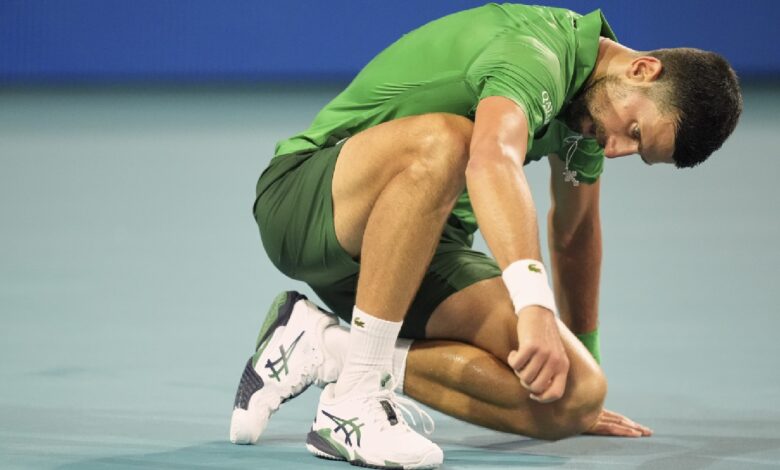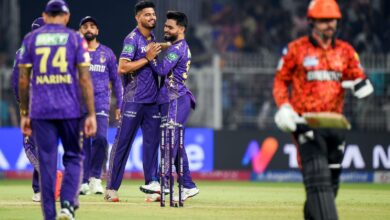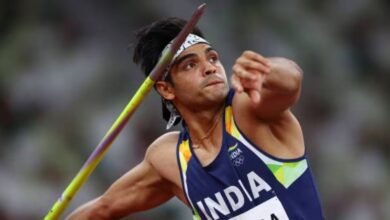Is tie-break master Novak Djokovic losing his edge | Tennis News

During the peak of his career, a peak that lasted more than a decade, there was no greater measure of Novak Djokovic’s dominance of men’s tennis than his record in tie-breakers. The Serb has won nearly two-thirds, 65.5 percent, of the tie-breakers he has played. Against the best opposition, top-10 ranked players, that number stands at 64.7 percent. At the Grand Slam stage, it would become one of his get-out-of-jail cards, dragging important matches in which he was not at his best into tie-breakers, where he would make his opponents blink first.However, on Sunday, in the final of a Masters 1000 event, against an opponent half his age and ranked 54th in the world, Djokovic lost two tie-breakers in the same match. Over the past 52 weeks, he has now won only five of the 10 breakers he has played.
Jakub Mensik, a rising 19-year-old from the Czech Republic, got one over his childhood idol, defeating Djokovic 7-6 (4), 7-6 (4) in the final of the Miami Open; foiling the 24-time Major winner’s quest for a 100th career title, but perhaps more importantly, dulling the 38-year-old’s message to his rivals that he is not quite done yet.
Story continues below this ad
Djokovic stayed firm for much of the match, despite facing some physical discomfort, and dragged both sets into the first- to-seven-points shootouts that one expects him to win. Instead, it was Mensik’s big serves, and Djokovic’s loose errors, that defined the match, leaving him only a few points away, in a winnable match, from the 100th title he has been seeking for over seven months now.
The Student Becomes The Master(s) Champion
The moment @mensik_jakub_ completed his 7-6 7-6 victory over Novak Djokovic! #MiamiOpen pic.twitter.com/GDqFHrvsPB
— Tennis TV (@TennV) March 31, 2025
Despite a reaffirming tournament in Miami, where he was reasonably blemish-free, albeit against significantly weaker opposition, the manner of his defeat in the final would once again hint at the fact that Djokovic’s aura of invincibility has shrunk, possibly even vanished, among his peers in the locker room. The former World No. 1 is now beatable even in match situations that suited him most in the past.
Father Time catching up
Djokovic has spent much of the last 18 months confronting the questions that ageing sporting greats often face in the twilight of their careers: is the current slump just a blip in form that can be overcome or is it the start of an out-and-out decline?
There have been plenty of signs of it being the former. Elite athletes do not simply forget their best attributes or fail to produce their peak levels: Djokovic put in vintage performances to beat Carlos Alcaraz in the Paris Olympics final last year and at the Australian Open this year.
But approaching 38, the challenge is to continue to produce that level with regularity, the way the brutal tennis calendar forces one to do. And the slip-ups are now creeping in with frequency.Story continues below this ad
However, there were mitigating factors to his loss in Sunday’s final. Mensik, for one, put in a phenomenal serving performance, especially under pressure. The big-hitting teenager had a remarkable run in Florida. He revealed after the final that he was about to withdraw from the tournament but his paperwork did not go through because the tournament referee was away for lunch, following which he decided to stay in the field and stormed to victory with two wins over top-10 players.
Djokovic’s vision had been impaired after a stye emerged under his right eye – making matters worse for a player who already competes wearing contact lenses. There was a near six-hour rain delay before the final, changing the conditions and making both players deal with the humidity.
But instead of pointing to these factors, the Serb was keen to put the spotlight on the youngster in whose development he has himself played a role. Djokovic had invited Mensik to Belgrade in 2022 as a practice partner when he was just 16, seeing the potential in him.
“Congratulations to Mensik and his team,” he said after Sunday’s final. “I am never really happy to lose, but he’s one of the very few players that I would be happier to lose to, to be honest.Story continues below this ad
“I saw him play when he was 16 and invited him for some training blocks together. He was training at my club in Belgrade, and to see his development and evolution is amazing. I could already see back then three years ago that he’s going to be one of the top players in the world.”
Gracious loser
When asked to explain some of the issues he faced in the final, Djokovic had none of it, saying: “I prefer not to talk about (physical issues). There are quite a few things, but I prefer to just congratulate him. That’s it. I don’t want to sound like I’m giving excuses for my loss.”
Physical issues, big and small – ranging from muscle tears to cramps and niggles – have dogged Djokovic of late. There have also been coaching and backroom staff changes, as well as slight tweaks in technique. He has also had to deal with heat, tournament schedules and gripes with broadcasters.
Even at his very best, Djokovic’s superiority over the rest of the field was never for obvious reasons; how he held the upper hand was almost imperceptible. The Serb would win matches percentages – he was only slightly worse in parts of the game where his opponents were better, but his strengths would hugely outweigh theirs.Story continues below this ad
His current struggles seem imperceptible too. Whether he is unable to produce the same level because of a slowness in his reflexes or a shrinking in power due to age, wear and tear on his body due to the decades he has spent on the tour, or an evolution in the game itself, is hard to call. Perhaps it is a combination of all these factors.
But what his run in Miami confirmed is that men’s tennis’ greatest-ever player remains in a limbo: still capable of putting winning runs together and going deep in tournaments, but not quite able to reach the dizzying highs of his peak consently.
If he is able to get past this state, it may be the crowning achievement of the greatest resume in tennis hory.








